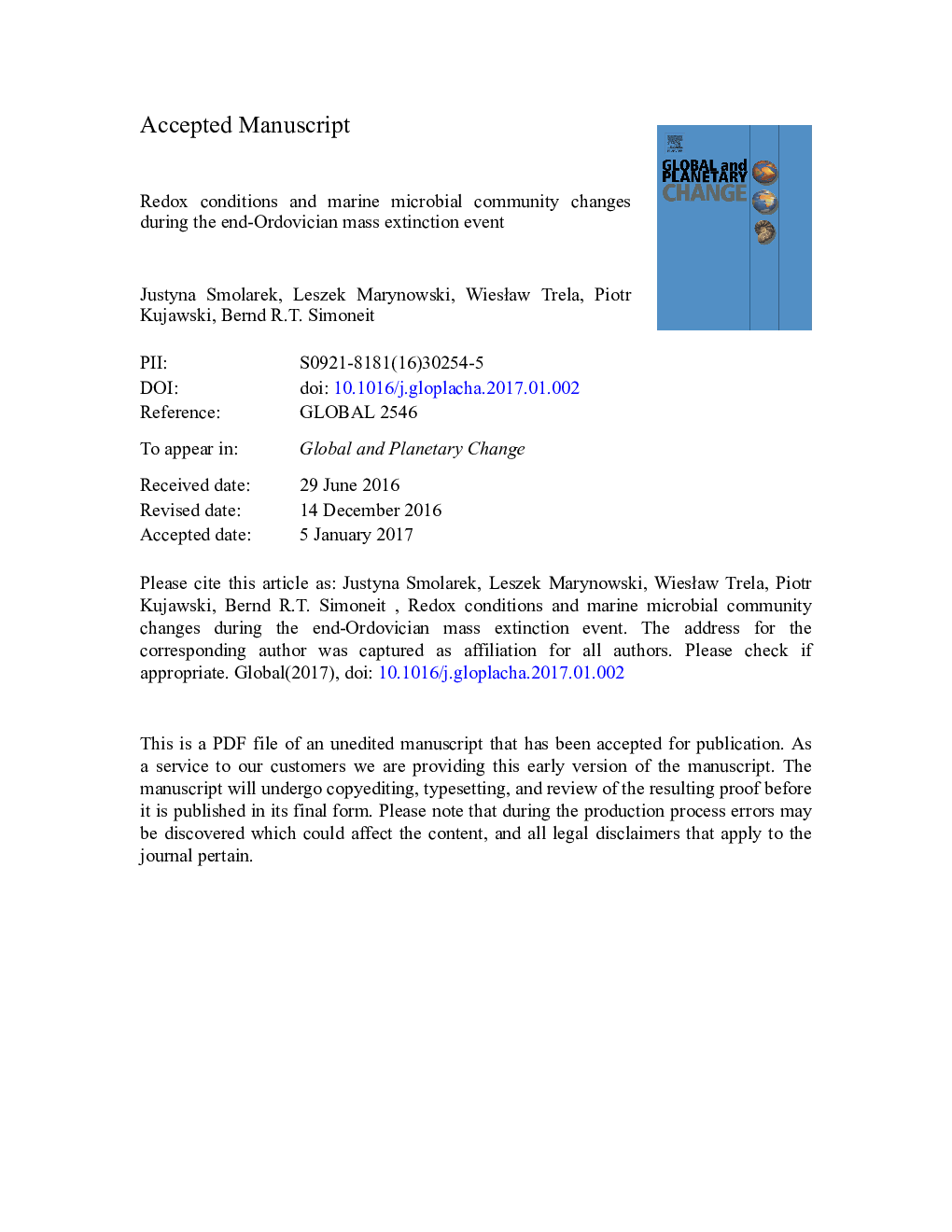| کد مقاله | کد نشریه | سال انتشار | مقاله انگلیسی | نسخه تمام متن |
|---|---|---|---|---|
| 5755299 | 1621633 | 2017 | 71 صفحه PDF | دانلود رایگان |
عنوان انگلیسی مقاله ISI
Redox conditions and marine microbial community changes during the end-Ordovician mass extinction event
دانلود مقاله + سفارش ترجمه
دانلود مقاله ISI انگلیسی
رایگان برای ایرانیان
کلمات کلیدی
موضوعات مرتبط
مهندسی و علوم پایه
علوم زمین و سیارات
فرآیندهای سطح زمین
پیش نمایش صفحه اول مقاله

چکیده انگلیسی
The end-Ordovician (Hirnantian) crisis is the first globally distinct extinction during the Phanerozoic, but its causes are still not fully known. Here, we present an integrated geochemical and petrographic analysis to understand the sedimentary conditions taking place before, during and after the Late Ordovician ice age. New data from the Zbrza (Holy Cross Mountains) and GoÅdap (Baltic Depression) boreholes shows that, like in other worldwide sections, the total organic carbon (TOC) content is elevated in the upper Katian and uppermost Hirnantian to Rhudannian black shales, but depleted (below 1%) during most of the Hirnantian. Euxinic conditions occurred in the photic zone in both TOC-rich intervals. This is based on the maleimide distribution, occurrence of aryl isoprenoids and isorenieratane, as well as a dominance of tiny pyrite framboids. Euxinic conditions were interrupted by the Hirnantian regression caused by glaciation. Sedimentation on the deep shelf changed to aerobic probably due to intense thermohaline circulation. Euxinia in the water column occurred directly during the time associated with the second pulse of the mass extinction with a termination of the end-Ordovician glaciation and sea level rise just at the Ordovician/Silurian (O/S) boundary. In contrast, we suggest based on inorganic proxies that bottom water conditions were generally oxic to dysoxic due to upwelling in the Rheic Ocean. The only episode of seafloor anoxia in the Zbrza basin was found at the O/S boundary, where all inorganic indicators showed elevated values typical for anoxia (U/Th > 1.25; V/Cr > 4.25; V/(V + Ni): 0.54-0.82 and Mo > 10-25 ppm). Significant differences in hopanes to steranes ratio and in C27-C29 sterane distribution between the Katian, Rhudannian and Hirnantian deposits indicate changes in marine microbial communities triggered by sharp climate change and Gondwana glaciation. The increase from biomarkers of cyanobacteria (2α-methylhopanes) after the O/S boundary implied enhanced microbial activity following the mass extinction event.
ناشر
Database: Elsevier - ScienceDirect (ساینس دایرکت)
Journal: Global and Planetary Change - Volume 149, February 2017, Pages 105-122
Journal: Global and Planetary Change - Volume 149, February 2017, Pages 105-122
نویسندگان
Justyna Smolarek, Leszek Marynowski, WiesÅaw Trela, Piotr Kujawski, Bernd R.T. Simoneit,